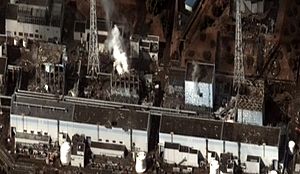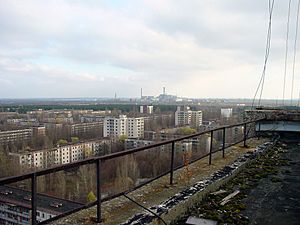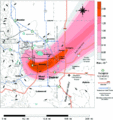Nuclear and radiation accidents facts for kids


The list of the worst disasters at nuclear power plants and other nuclear facilities all over the world is presented below:
One of the worst nuclear accidents to date was the Chernobyl disaster which occurred in 1986 in Ukraine. That accident killed 30 people directly, as well as damaging approximately $7 billion of property. A study published in 2005 estimates that there will eventually be up to 4,000 additional cancer deaths related to the accident among those exposed to significant radiation levels. Radioactive fallout from the accident was concentrated in areas of Belarus, Ukraine and Russia. Approximately 350,000 people were forcibly resettled away from these areas soon after the accident.
Some of the most serious nuclear and radiation accidents by death toll in the world have involved nuclear submarine mishaps. To-date, all of these were units of the former Soviet Union.
Contents
Normal accidents
Normal Accidents is a 1984 book by Yale sociologist Charles Perrow, which provides a detailed analysis of complex systems from a social sciences perspective. It was the first to characterize complex technological systems such as nuclear power plants according to their riskiness. Perrow says that multiple and unexpected failures are built into society's complex and tightly-coupled systems. Such accidents cannot be designed around.
The inspiration for Perrow's books was the 1979 Three Mile Island accident, where a nuclear accident resulted from an unanticipated interaction of multiple failures in a complex system. The event was an example of a normal accident because it was "unexpected, incomprehensible, uncontrollable and unavoidable".
Perrow's argument rests on three principles. Firstly, people make mistakes, even at nuclear plants. Secondly, big accidents almost always escalate from very small beginnings. Thirdly, many failures are those of organizations more than technology. Each of these principles is still relevant today.
Nuclear power
| Date | Location of accident | Description of accident | Dead | Cost ($US millions 2006 ) |
INES Scale |
|---|---|---|---|---|---|
| October 10, 1957 | Sellafield, Cumberland, United Kingdom | A fire at the British atomic bomb project destroyed the core and released radioactive material into the environment. | 0 | 5 | |
| January 3, 1961 | Idaho Falls, Idaho, United States | Explosion at SL-1 prototype at the National Reactor Testing Station. All 3 operators were killed when a control rod was removed too far. | 3 | 22 | 4 |
| October 5, 1966 | Frenchtown Charter Township, Michigan, United States | Partial core meltdown of the Fermi 1 Reactor at the Enrico Fermi Nuclear Generating Station. | 0 | 132 | |
| January 21, 1969 | Lucens reactor, Vaud, Switzerland | Loss-of-coolant accident, leading to a partial core meltdown and massive radioactive contamination of the cavern, which was then sealed. | 0 | 4 | |
| 1975 | Sosnovyi Bor, Leningrad Oblast, Russia | There was reportedly a partial nuclear meltdown in Leningrad nuclear power plant reactor unit 1. | |||
| December 7, 1975 | Greifswald, East Germany | Electrical error causes fire in the main trough that destroys control lines and five main coolant pumps | 0 | 443 | 3 |
| January 5, 1976 | Jaslovské Bohunice, Czechoslovakia | Malfunction during fuel replacement. Fuel rod ejected from reactor into the reactor hall by coolant (CO2). | 2 | 4 | |
| February 22, 1977 | Jaslovské Bohunice, Czechoslovakia | Severe corrosion of reactor and release of radioactivity into the plant area, necessitating total decommission | 0 | 1,700 | 4 |
| March 28, 1979 | Three Mile Island, Pennsylvania, United States | Loss of coolant and partial core meltdown due to operator errors. There is a small release of radioactive gases. | 0 | 2,400 | 5 |
| September 15, 1984 | Athens, Alabama, United States | Safety violations, operator error, and design problems force a six-year outage at Browns Ferry Unit 2. | 0 | 110 | |
| March 9, 1985 | Athens, Alabama, United States | Instrumentation systems malfunction during startup, which led to suspension of operations at all three Browns Ferry Units | 0 | 1,830 | |
| April 11, 1986 | Plymouth, Massachusetts, United States | Recurring equipment problems force emergency shutdown of Boston Edison’s Pilgrim Nuclear Power Plant | 0 | 1,001 | |
| April 26, 1986 | Chernobyl disaster, Ukrainian SSR | Overheating, steam explosion, fire, and meltdown, necessitating the evacuation of 300,000 people from Chernobyl and dispersing radioactive material across Europe | 56 direct; 4,000 to 985,000 cancer |
6,700 | 7 |
| May 4, 1986 | Hamm-Uentrop, Germany | Experimental THTR-300 reactor releases small amounts of fission products (0.1 GBq Co-60, Cs-137, Pa-233) to surrounding area | 0 | 267 | |
| March 31, 1987 | Delta, Pennsylvania, United States | Peach Bottom units 2 and 3 shutdown due to cooling malfunctions and unexplained equipment problems | 0 | 400 | |
| December 19, 1987 | Lycoming, New York, United States | Malfunctions force Niagara Mohawk Power Corporation to shut down Nine Mile Point Unit 1 | 0 | 150 | |
| March 17, 1989 | Lusby, Maryland, United States | Inspections at Calvert Cliff Units 1 and 2 reveal cracks at pressurized heater sleeves, forcing extended shutdowns | 0 | 120 | |
| March 1992 | Sosnovyi Bor, Leningrad Oblast, Russia | An accident at the Sosnovy Bor nuclear plant leaked radioactive gases and iodine into the air through a ruptured fuel channel. | |||
| February 20, 1996 | Waterford, Connecticut, United States | Leaking valve forces shutdown Millstone Nuclear Power Plant Units 1 and 2, multiple equipment failures found | 0 | 254 | |
| September 2, 1996 | Crystal River, Florida, United States | Equipment malfunction forces shutdown and extensive repairs at Crystal River Unit 3 | 0 | 384 | |
| September 30, 1999 | Ibaraki Prefecture, Japan | Tokaimura nuclear accident killed two workers, and exposed one more to radiation levels above permissible limits. | 2 | 54 | 4 |
| February 16, 2002 | Oak Harbor, Ohio, United States | Severe corrosion of control rod forces 24-month outage of Davis-Besse reactor | 0 | 143 | 3 |
| August 9, 2004 | Fukui Prefecture, Japan | Steam explosion at Mihama Nuclear Power Plant kills 4 workers and injures 7 more | 4 | 9 | 1 |
| July 25, 2006 | Forsmark, Sweden | An electrical fault at Forsmark Nuclear Power Plant caused one reactor to be shut down | 0 | 100 | 2 |
| March 11, 2011 | Fukushima, Japan | A tsunami flooded and damaged the 5 active reactor plants drowning two workers. Loss of backup electrical power led to overheating, meltdowns, and evacuations. One man died suddenly while carrying equipment during the clean-up. | 7 | ||
| 12 September 2011 | Marcoule, France | One person was killed and four injured, one seriously, in a blast at the Marcoule Nuclear Site. The explosion took place in a furnace used to melt metallic waste. | 1 |
Nuclear submarines
Some of the most serious nuclear and radiation accidents by death toll in the world have involved nuclear submarine mishaps. To-date, all of these were units of the former Soviet Union. Reactor accidents that resulted in core damage and release of radioactivity from nuclear-powered submarines include:
- K-8, 1960, loss-of-coolant accident; substantial radioactivity released.
- K-14, 1961, reactor compartment replaced due to unspecified "breakdown of reactor protection systems."
- K-19, 1961, loss-of-coolant accident resulting in 8 deaths and more than 30 other people being over-exposed to radiation. The events on board the submarine are dramatized by the film K-19: The Widowmaker.
- K-11, 1965, both reactors damaged during refueling while lifting the reactor vessel heads; reactor compartments scuttled off the east coast of Novaya Zemlya in the Kara Sea in 1966.
- K-27, 1968, experienced reactor core damage to one of its reactors, resulting in 9 fatalities and 83 other injuries; scuttled in the Kara Sea in 1982.
- K-140, 1968, reactor damaged following an uncontrolled, automatic increase in power during shipyard work.
- K-429, 1970, an uncontrolled start up of the ship's reactor led to a fire and the release of radioactivity
- K-116, 1970, loss-of-coolant accident in the port reactor; substantial radioactivity released.
- K-64, 1972, failure of the first Alfa-class liquid-metal cooled reactor; reactor compartment scrapped.
- K-222, 1980, Papa-class submarine had a reactor accident during maintenance in the shipyard while the ship's naval crew had left for lunch.
- K-123, 1982, Alfa-class submarine reactor core damaged by liquid-metal coolant leak; the sub was forced out of commission for eight years.
- K-431, 1985, a reactor accident while refueling resulted in 10 fatalities and 49 other people suffered radiation injuries.
- K-219, 1986, suffered an explosion and fire in a missile tube, eventually leading to a reactor accident; a 20-year old enlisted seaman, Sergei Preminin, sacrificed his life to secure one of the onboard reactors. The submarine sank three days later.
- K-192, 1989, loss-of-coolant accident; reclassified from K-131.
Radiotherapy accidents
| Year | Type | Accident | ARS fatalities | ARS survivors | Location |
|---|---|---|---|---|---|
| 1957 | alleged crime | Nikolay Khokhlov assassination attempt | 0 | 1 | Frankfurt, West Germany |
| 1962 | orphan source | radiation accident in Mexico City | 4 | ? | Mexico City, Mexico |
| 1985 | radiotherapy | Therac-25 radiation overdose accidents | 3 | 3 | |
| 1984 | orphan source | radiation accident in Morocco | 8 | 3 | Mohammedia, Morocco |
| 1987 | orphan source | Goiânia accident | 4 | ? | Goiânia, Brazil |
| 1990 | radiotherapy | radiotherapy accident in Zaragoza | 11 | ? | Zaragoza, Spain |
| 1996 | radiotherapy | radiotherapy accident in Costa Rica | 7 to 20 | 46 | San José, Costa Rica |
| 2000 | orphan source | Samut Prakan radiation accident | 3 | 7 | Samut Prakan Province, Thailand |
| 2000 | radiotherapy | Instituto Oncologico Nacional accident | 3 to 7 | ? | Panama City, Panama |
| 2006 | crime | Poisoning of Alexander Litvinenko | 1 | 0 | London, United Kingdom |
| 2010 | orphan source | Mayapuri radiological accident | 1 | 7 | Mayapuri, India |
Images for kids
-
Dr. Joseph G. Hamilton was the primary researcher for the human plutonium experiments done at U.C. San Francisco from 1944 to 1947. Hamilton wrote a memo in 1950 discouraging further human experiments because the AEC would be left open "to considerable criticism," since the experiments as proposed had "a little of the Buchenwald touch."
-
One of four example estimates of the plutonium (Pu-239) plume from the 1957 fire at the Rocky Flats Nuclear Weapons Plant near Denver, Colorado. Public protests and a combined Federal Bureau of Investigation and United States Environmental Protection Agency raid in 1989 stopped production at the plant.
-
Corroded and leaking 55-gallon drum, for storing radioactive waste at the Rocky Flats Plant, tipped on its side so the bottom is showing.
-
The Hanford site represents two-thirds of USA's high-level radioactive waste by volume. Nuclear reactors line the riverbank at the Hanford Site along the Columbia River in January 1960.
-
The 18,000 km2 expanse of the Semipalatinsk Test Site (indicated in red), which covers an area the size of Wales. The Soviet Union conducted 456 nuclear tests at Semipalatinsk from 1949 until 1989 with little regard for their effect on the local people or environment. The full impact of radiation exposure was hidden for many years by Soviet authorities and has only come to light since the test site closed in 1991.
-
Over 2,000 nuclear tests have been conducted, in over a dozen different sites around the world. Red Russia/Soviet Union, blue France, light blue United States, violet Britain, black Israel, yellow China, orange India, brown Pakistan, green North Korea and light green Australia (territories exposed to nuclear bombs)
-
Radioactive materials were accidentally released from the 1970 Baneberry Nuclear Test at the Nevada Test Site.
-
The recovered thermonuclear bomb was displayed by U.S. Navy officials on the fantail of the submarine rescue ship U.S.S. Petrel after it was located in the sea off the coast of Spain at a depth of 762 meters and recovered in April 1966
-
A sketch used by doctors to determine the amount of radiation to which each person had been exposed during the Slotin excursion
See also
 In Spanish: Accidente nuclear para niños
In Spanish: Accidente nuclear para niños














